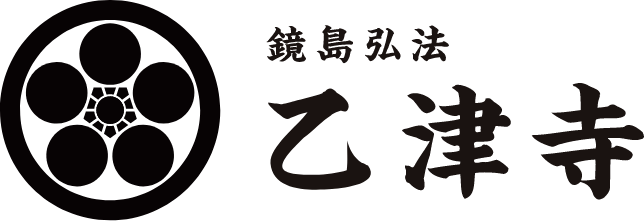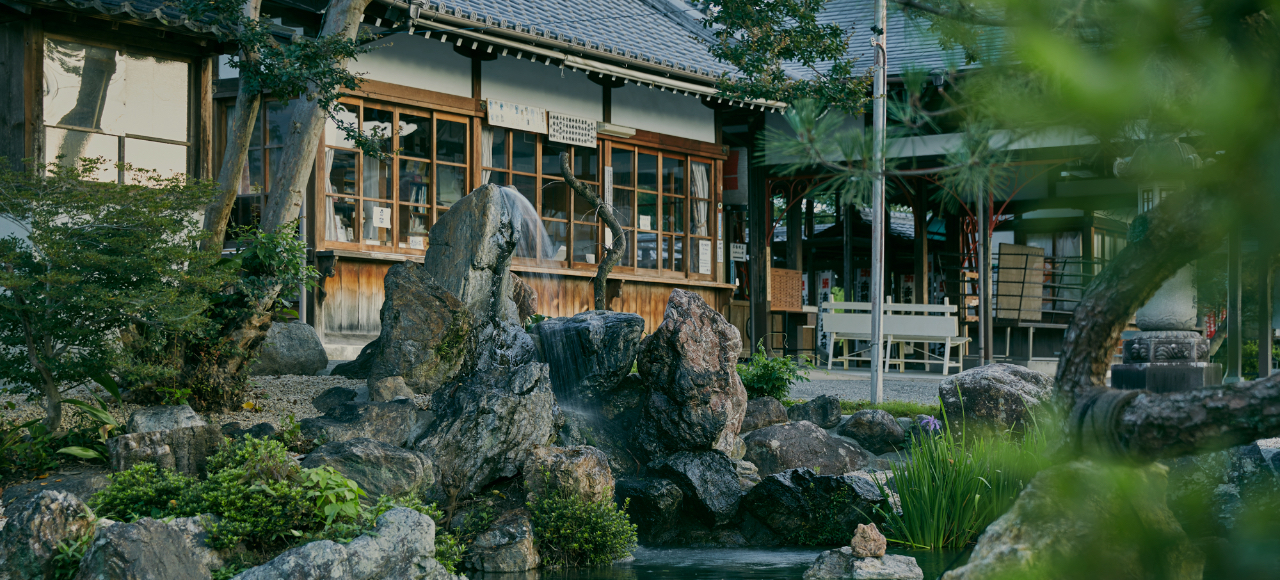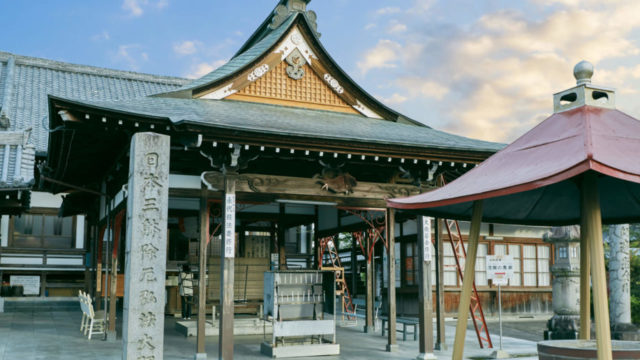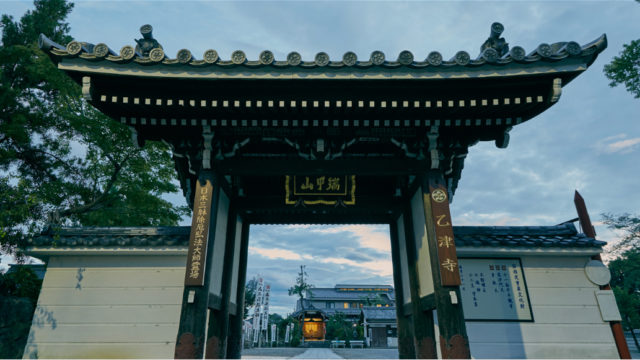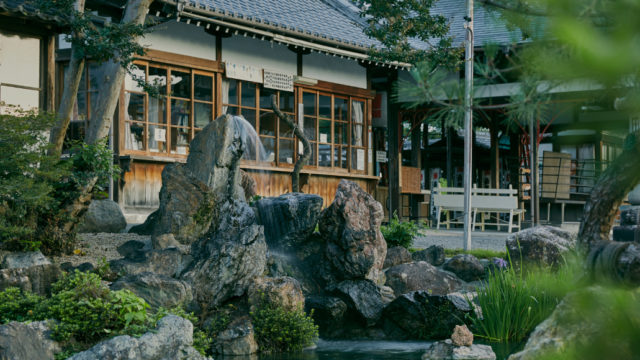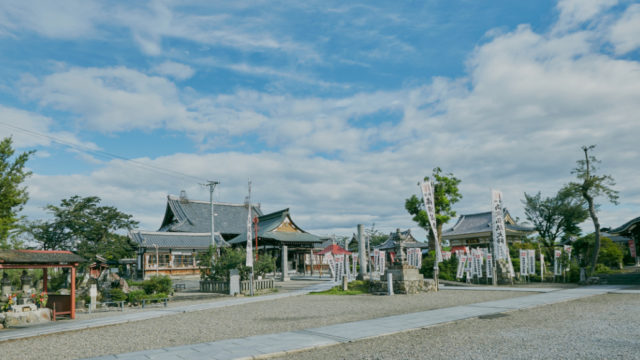Enjoy the Highlights of the Time-Honored Temple with Over 1200 Years of History
With more than 1200 years of history since Kōbō Daishi established the temple, visitors can find a lot of must-see features in its compound while enjoying its historical atmosphere: the statue of Jūichimen Senju Kannon Bosatsu, and many other Buddhist images and Heavenly Deities such as Shichifukujin (Seven Deities of Good Fortune).
Kōbō Daishi
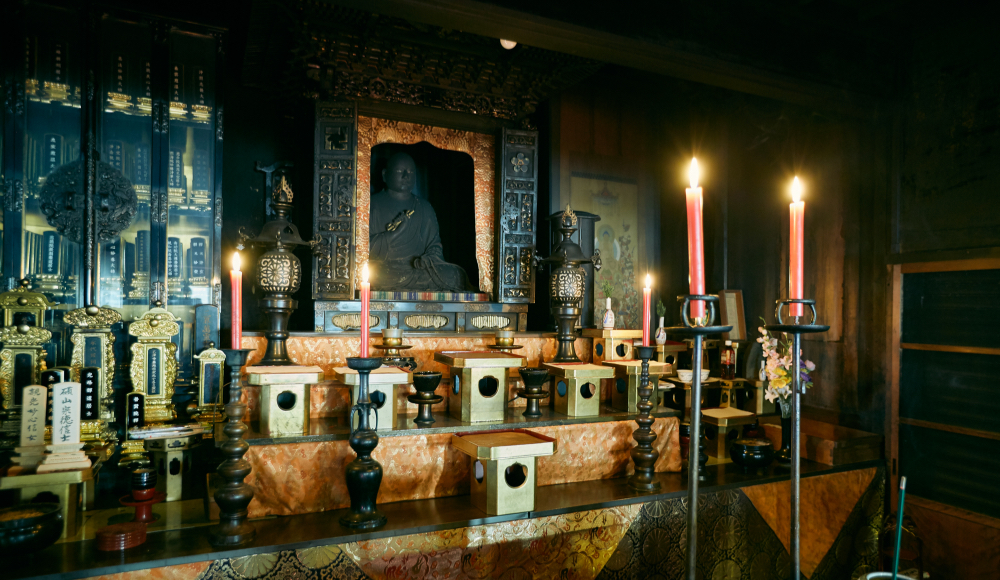
Life-Sized Seated Statue Carved by Kōbō Daishi Himself
Located behind the worship hall within the compound, the Daishidō hall enshrines a statue of Kōbō Daishi that he himself carved when he was 42. This statue has a juzu rosary in his left hand that is placed on top of his knee while holding a gokosho (five-prong pestle used in esoteric Buddhist rituals) in his right hand in front of his chest. This statue is open to the public only during the period of April 21st to 23rd every year.
Daishido
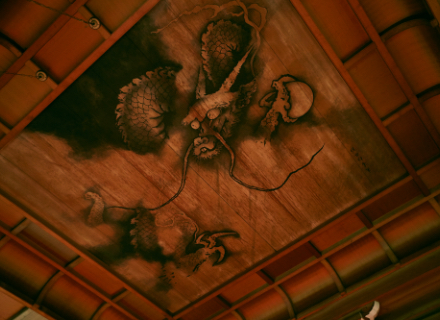
This is the hall where Kōbō Daishi is worshipped. Although it was once destroyed in the 1945 air raids over Gifu during World War Ⅱ, the hall was restored in 1958. On its ceiling, visitors can find an ink painting, the “Dragon and Clouds” that depicts the Dragon God glaring in 8 directions. This Japanese-style painting was created by the master painter, Dōmoto Inshō (Recipient of the Order of Culture) who was associated with the temple.
The Daishido Hall
Ume Associated with Kōbō Daishi
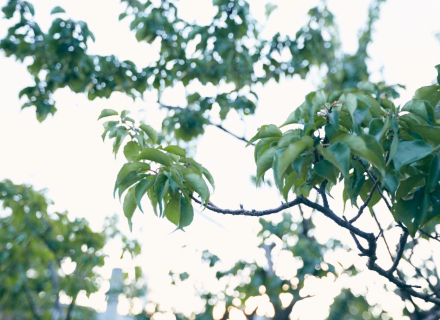
When Kōbō Daishi established the Osshinji Temple under the Imperial order of Emperor Saga, he planted a “staff made from ume (Japanese plum tree)” in front of the main hall. According to a legend, this staff immediately grew into an ume tree with a lot of branches and leaves. Since then, this temple has been dubbed as Umedera (the temple of ume). The Japanese plum trees derived from this legend still bloom in early spring every year within the compound.
East of the pond
Hon-Shikoku 88 Temples Pilgrimage
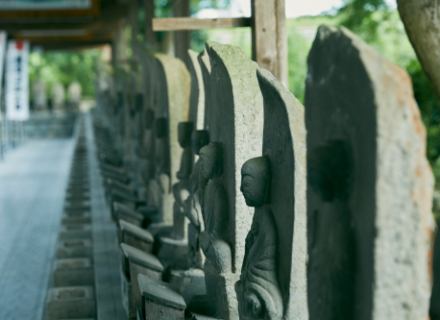
This area reproduces the 88 temples pilgrimage in the Shikoku Region associated with Kōbō Daishi. Visitors can virtually experience the Shikoku Pilgrimage in this area as they can find a collection of stone images that represent the main images of each of these 88 temples. With the spirit of “Dōgyō-ninin (two people, one practice: a pilgrimage is a journey with Kōbō Daishi),” each of these images is worshipped together with the stone image of Kōbō Daishi with the earth and sand brought from its actual site stored underneath.
North of the Daishidō Hall
Jūichimen Senju Kannon Bosatsu
Eleven-Faced, Thousand-Armed Deity of Mercy
(National Important Cultural Property)
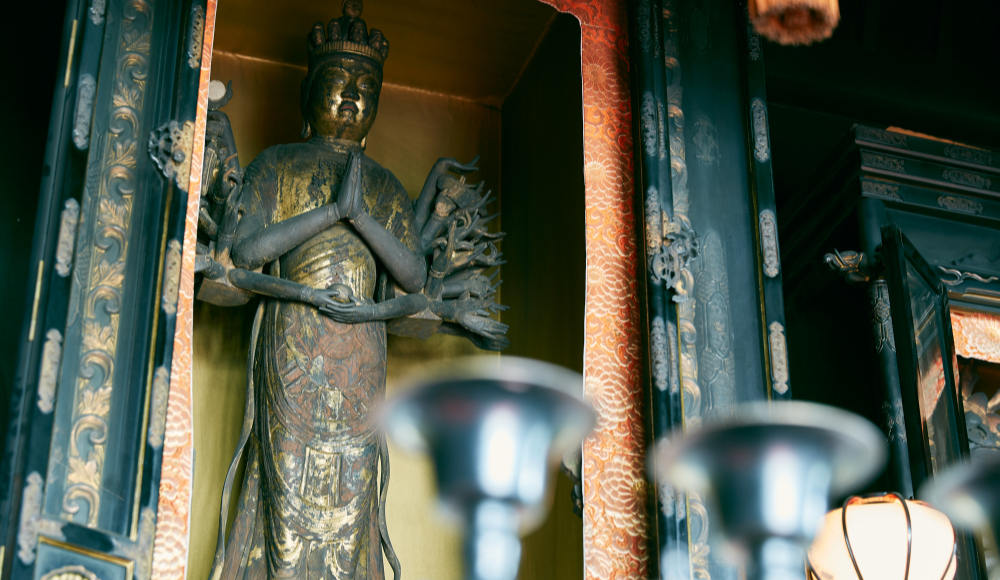
Exuding Profound Compassion, This Statue Represents the Deity of Mercy Who Saves All Living Beings
Carved around the 700s (the Tempyo Period), this standing statue has been the main image of the Osshinji Temple over a period of more than 1200 years. Each of its eleven faces expresses various human emotions of delight, anger, sorrow and pleasure while each of its 40 arms extending on both sides, except for two that are clasped in the front, is said to save the beings of the 25 Buddhist worlds. This Deity of Mercy saves people from any worries and sufferings.
The Treasure Hall
Bishamonten
Heavenly Deity of Warriors and Punisher of Evil-Doers
(National Important Cultural Property)
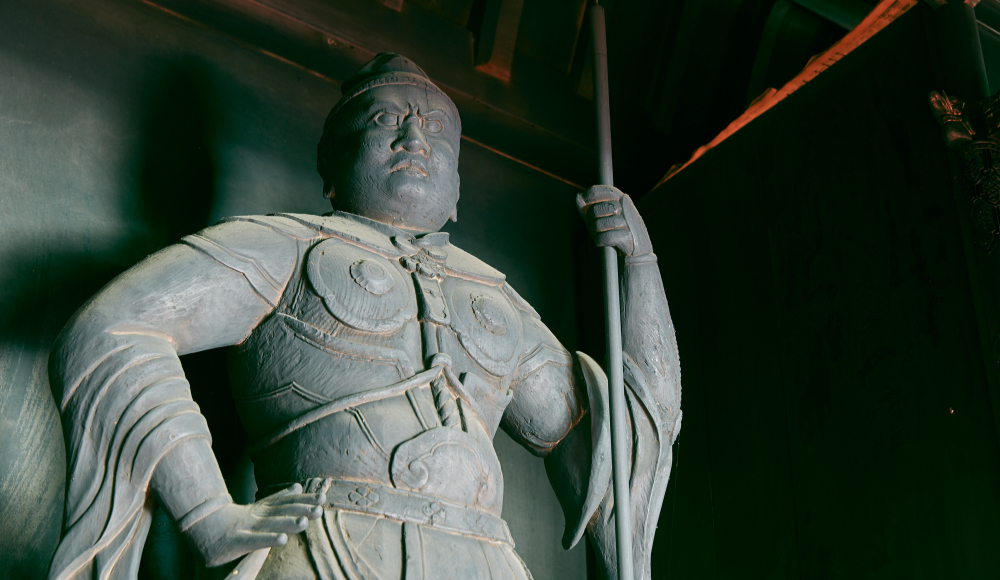
The Unique Statue of Bishamonten in the Tokai Region
This statue was reportedly carved by Kōbō Daishi during the Fujiwara Period (around the 900s) that falls during the mid-to-late Heian Period. It is characterized by its posture known as the “Kuramadera Temple style”; its left hand holds a geki (ancient Chinese spear) while its right hand is placed on its waist. This style can be found very rarely in Japan, and the Osshinji Temple is the only temple in the Tokai region that owns this style of Bishamonten.
The Treasure Hall
Idaten
Swift-Footed Heavenly Guardian Deity
(National Important Cultural Property)
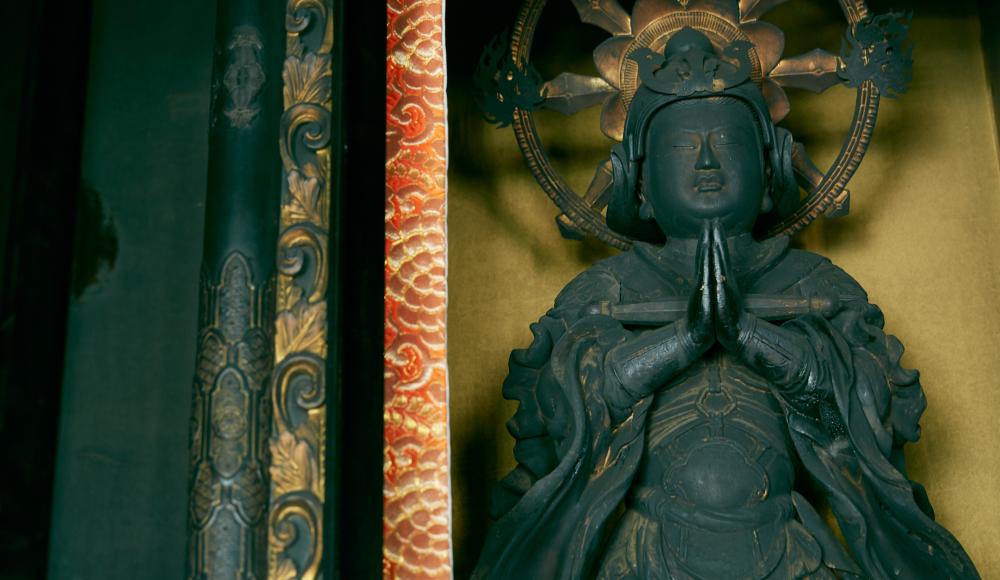
The Expression, “Idaten-Bashiri (Running Very Fast Like Idaten)” is Derived from This Buddhist Deity
Dating back to the Kamakura Period (around the 1200s), this is one of the oldest and biggest statues of Idaten in Japan. This Deity is famous for its fleet of foot; according to a legend, he chased after and caught an ogre god that stole the Buddha’s ashes. In addition, he devoted himself to searching for food for Buddha. Because of this, Idaten is believed to free us from hunger.
The Treasure Hall
Fudōmyō-ō (Immovable King of Brightness)
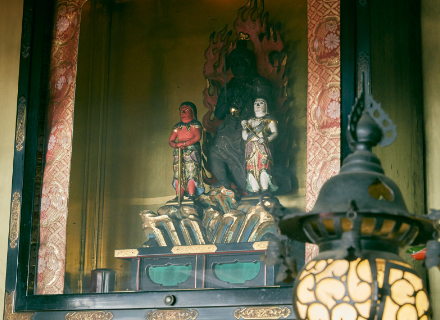
The Venerable King of Brightness Familiarly Called “Ofudō-san”
Fudōomyō-ō is the central Deity among the 5 major Myō-ō (Kings of Brightness) and said to be the manifestation of Dainichi Nyorai (Supreme Buddha of the Cosmos). When Kōbō Daishi was on his way back to Japan from China where he studied Buddhism, his boat was hit by a heavy storm but he chanted the Shingon (mantra) for Fudomyō-ō and overcame the disaster. This statue is flanked by Kongaradoji and Seitakadoji that are part of the Myō-ō’s 36 followers known as 36 Dōji (great youths).
The Fudōdō Hall
Shichifukujin (Seven Deities of Good Fortune)
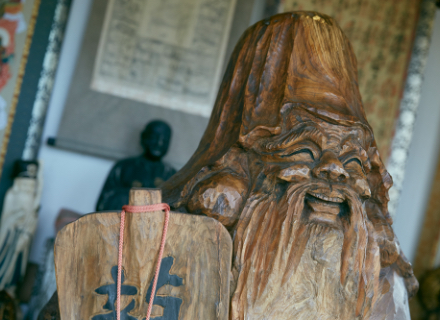
Seven Deities That Bring over Various Fortune
Within the compound, visitors can find and pray to all of the Seven Deities of Good Fortune for their own benefits: Daikokuten (God of wealth and prosperity), Ebisu (God of fishermen and merchants), Bishamonten (God of warriors and punisher of evil-doers), Benzaiten (God of music, arts and knowledge), Hotei (God of happiness and abundance), Fukurokuju (God of wealth, happiness and longevity), and Jurōjin (God of wisdom and longevity). This has been well-received by visitors because they are able to pray to all of the Deities at one visit.
East of the Daishidō Hall,East of the waiting area,West of the pond
Guardian Buddhist Deities for the Twelve Chinese Zodiac Signs
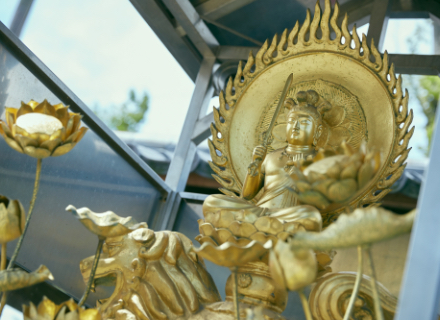
Pray to Your Own Guardian Deity Based on Your Birth Year
This temple worships Guardian Buddhist Deities for each of the twelve signs of the Chinese Zodiac: Rat, Ox, Tiger, Rabbit, Dragon, Serpent, Horse, Sheep, Monkey, Rooster, Dog, and Boar. Pray and chant the shingon (mantra) to the Guardian Deity of your birth year.
The Treasure Hall, The Fudōdō Hall, and West of the Daishidō Hall
Various Shinto and Buddhist Deities
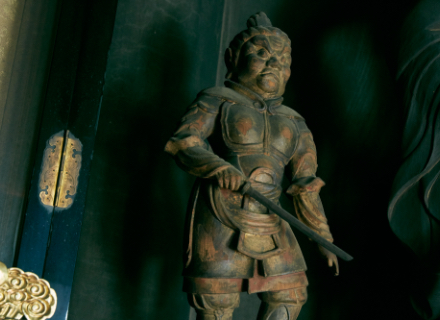
Praying to a Wide Variety of Shinto and Buddhist Deities
Within the compound, there are a wide variety of images of Shinto and Buddhist Deities: the Senbu Daimyōjin Shrine that worships the boatman who brought Kōbō Daishi to the temple; various kinds of Jizō Bosatsu (Buddhist Guardian Deities believed to protect people, especially children and travelers) including Gan Jizō (Jizō to make wishes), Enmei Jizō (Life Prolonging Jizō), and Mizumuke Jizō (Water Covered Jizō); the Shoichii Inari Daimyojin Shrine (God of harvests, wealth, fertility, and business prosperity); and Daishō Kangiten (a Heavenly Guardian Deity). “Omokaru-san” or Omokaruishi (Heavy or Light Stone) tells you, by the feel of its heaviness when you lift it, whether or not your wish will be answered.
Mausoleum of Nirvana
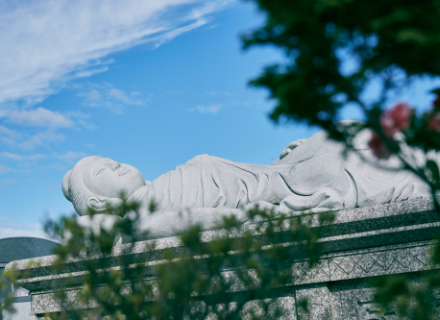
Statue of the Reclining Buddha, the Symbol of the Grand Joint Grave
Located in the northwestern part of the temple’s compound, the “Mausoleum of Nirvana” is the grand joint grave for those who entrust the temple with Buddhist services to their ancestors perpetually on behalf of them. Nirvana indicates a transcendent state of enlightenment and peace where the fire of worldly desires has been extinguished while the light of wisdom has been completed. This place brings peace of mind to visitors.
North of the grounds
Learn More about the Osshinji Temple
